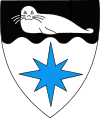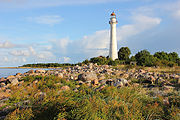Kihnu
| Kihnu | |||
|
|||
| State : |
|
||
| Circle : |
|
||
| Coordinates : | 58 ° 8 ' N , 23 ° 59' E | ||
| Area : | 16.65 km² | ||
| Residents : | 701 (January 1, 2017) | ||
| Population density : | 42 inhabitants per km² | ||
| Time zone : | EET (UTC + 2) | ||
| Postal address : | Säär küla 88005 Kihnu vald |
||
| Website : | |||

|
|||
Kihnu ( Swedish Kynö , German outdated Kühnö ) is the seventh largest Estonian island with 16.38 km² . Politically it is an independent municipality in Pärnu County .
It is located around 12 kilometers south of the Tõstamaa peninsula in the Gulf of Riga . In addition to the main island, the municipality of Kihnu also includes a few uninhabited tiny islands, a total of 16.65 km².
In 2017 there were 701 people on Kihnu. They are spread over the four villages of Lemsi, Linaküla, Rootsiküla and Sääre. Lemsi is the port of the island. There is a ferry connection to Manilaid as well as to Pärnu on the mainland. In autumn and winter there is also a flight connection to Pärnu; the Kihnu airfield is in Säärekülä, as is the town hall and the post office. In winter, the strait between Kihnu and the mainland often freezes over, so the island can be reached by car over the ice.
The inclusion of the cultural area of the island by the UNESCO led UNESCO Intangible Cultural Heritage Lists found Kihnu in 2003 and 2008 due to its compared to the mainland still relatively vibrant traditions and the peculiar dialect. However, only a few women still wear the traditional costume (colored woolen skirts and an apron) in everyday life. With the modernization during the time of the Soviet Union , a large part of the traditions on Kihnu came under pressure: many male islanders, almost all of whom had previously worked at sea, found work in the now mechanized agriculture. Although this reduced the predominantly female character of island life, Kinuh's culture is still often referred to as the “last matriarchal society in Europe” (albeit without matrilineal descent and without the matrilocal residence of married couples). In the past, women had largely tended the agriculture on their own. Even today they drive many community projects forward and the members of the city council are mostly at least half female.
The inclusion in the Unesco list took place through the advocacy of the well-known documentary filmmaker Mark Soosaar and the wife of the former President Arnold Rüütel , the folklorist Ingrid Rüütel .
Today, as in many rural areas of Estonia, there is little work on Kihnu. A branch of industry with prospects seems to be tourism due to the UNESCO protection status. There is already a folklore ensemble on the island that performs traditional songs and dance from Kihnu for tourists. The driving force is the former mayor Annely Akkerman, who was born on Kihnu and heads the ferry company (Kihnu Veeteed) and the local tourism agency (AS Kihnurand).
Web links
- Island administration: Official website (Estonian).
- Kihnu Cultural Space Foundation: Official website (English).
- 360 ° air panorama: Kihnu. In: estonia360.ee. (Helicopter camera).
- Rachel Brown, Fabian Weiss (pictures): History and culture: Europe's island of matriarchs. In: NationalGeographic.de . March 3, 2020 (“Kihnu's unique, ancient culture, mostly cultivated by women”).
- Danel Rinaldo: Kihnu - the enchanting island that has fallen out of time. In: VisitEstonia.com. May 13, 2019.
- Andrea Jeska: Kihnu in Estonia: The island of silence. In: Der Spiegel . 29th March 2018.
- Video by Julia Finkernagel: One year on Kihnu in Estonia. In: MDR television . April 20, 2019 (43:15 minutes).
Individual evidence
- ↑ Monika Hippe: Icy Estonia. In: Südwest Presse . November 18, 2017, accessed June 28, 2020 .
- ^ Kihnu Cultural Space Foundation: Official website. Accessed on June 28, 2020 (English): "It ['] s culture, communal lifestyle, local dialect, traditions and music are what make it unique."
- ↑ Rachel Brown: History and Culture: Europe's Island of Matriarchs. In: NationalGeographic.de . March 3, 2020, accessed June 28, 2020.





